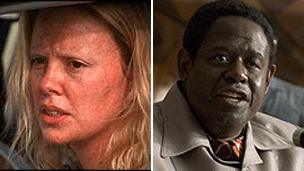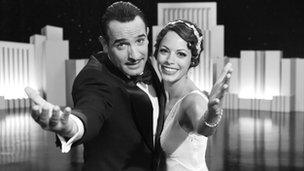How to win an Oscar
- Published
Are certain roles more likely to be rewarded with an Academy Award than others? We've looked back at best actor and actress Oscar winners since 1927 to try to find out.
Southern belles, frustrated spinsters, power-hungry TV execs, nuns, clergymen and even kings and queens. Over the years Oscar has rewarded actors and actresses for their portrayal of an wide array of characters, both real and fictional.
But, patterns have emerged. There are, it appears, certain types of roles that consistently act as Academy bait. As a result, we've come up with five ways wannabe Oscar winners could improve their chances of landing an award.Empire magazine's, externalHelen O'Hara helps explain our findings.
1. Play a real person
Almost one in five (19%) of the best-actor Oscars have gone to performers playing a character based on a real person.
Just last year Colin Firth won for his portrayal of George VI battling a stammer in theKing's Speech, external, two years earlier Sean Penn claimed an award for playing American gay rights activist HarveyMilk, external, and two years prior to that Oscar rewarded Forest Whitaker for his depiction of genocidal Ugandan dictator Idi Amin in theThe Last King of Scotland, external.

Charlize Theron and Forest Whitaker both won for playing controversial figures
When it comes to women, playing real also scores highly, but not quite as highly as for men. Some 13% of Oscar-winning actresses have won for a biopic role.
Recent winners include Marion Cotillard for playing troubled, tempestuous singer Edith Piaf inLa Vie en Rose, external, Helen Mirren for her portrayal ofThe Queen, externaland Reese Witherspoon for embodying singer June Carter in the Johnny Cash biopicWalk the Line, external.
So why does the Academy appear to reward biopic performances over others?
"In a way it is about the difficulty of judging art," explains O'Hara. "It is extremely difficult to see what difference is made and which performance is better than another. But when an actor plays a real person, you can judge a little better."
It also helps if a performer changes their physical appearance, she says, such as Charlize Theron for her portrayal of serial killer Aileen Wuornos in 2003'sMonster, external, for which the actress gained 30lb and donned heavy make-up.
"Hollywood is obsessed with being beautiful and slim, and is inordinately impressed by people who are prepared to look ugly. It is seen as courageous for art. This is particularly true for women."
2. Play a character with a disability
Across both the best actor and actress categories, portrayals of physical disability or mental illness are also highly rewarded.
A total of 16% of all winners played such roles. For men the percentage is slightly higher, at 17%, compared with 14% for women.
O'Hara says these performances are rewarded, in part, in the same way as those portraying real characters - the ease of assessing a performance.
But perhaps it is also the preparation that goes into these roles that impresses the Academy members so much.
For example, Dustin Hoffman reportedly spent a year working with young autistic men and their families in order to prepare for his role inRain Man, external, which won him a best actor Oscar in 1988.
The following year, famed method actor Daniel Day-Lewis took the award for his portrayal of Christy Brown, an Irish writer and artist born with cerebral palsy, inMy Left Foot, external. He was said to have formed friendships with several people with disabilities and refused to come out of character on set, remaining in his wheelchair between takes.
However, such physical disabilities feature among the Oscar-winning roles much less than mental illness and drink and drug dependency - subject matter much better understood in Hollywood, O'Hara suggests.
"Daniel Day-Lewis was the exception rather than the rule."
Yet, despite being rewarded well in Hollywood, performances by non-disabled performers in disabled roles are not celebrated by some disability campaigners, who describe acting disabled as akin to blacking up. TheDon't Play Me, Pay Me, externalgroup says that while there are disabled actors who are ready, eager and able to take on these parts, as well as other non-disability-specific roles, they should do so.
3. If you're male, play a leader or someone with an alcohol addiction
Some 13%, almost one in eight, of best actor winners played a politician, leader or member of royalty.

Humphrey Bogart is among the many actors who have been rewarded for their portrayal of drunks
This trend dates back to the early years of the Oscars, when winners included George Arliss for his performance as British Prime Minister Benjamin Disraeli inDisraeli, externalin 1929/30, and Charles Laughton for his portrayal of Henry VIII on thePrivate Life of Henry VIII, externalthree years later.
In the 1960s came Paul Scofield's Sir Thomas More inA Man for All Seasons, external, and in the 1980s Ben Kingsley'sGandhi., external
Paying a character struggling with alcohol addiction is also rewarded well among male performers. Some 17% of best actor winners played such a role - almost one in six.
"Alcohol and drug abuse are closer to the Hollywood experience, " says O'Hara. "And these are closely associated with Oscar nominations."
Oscar-winning performances of alcoholism include Humphrey Bogart's gin-swilling boat captain Charlie Allnut in theThe African Queen, externalin 1951, John Wayne's US Marshal Rooster Cogburn inTrue Grit, externalin 1969, Nicolas Cage's Ben Sanderson inLeaving Las Vegas, externalin 1995, and most recently Jeff Bridges' Otis "Bad" Blake inCrazy Heart, externalin 2009.
4. If you're female, play a single mother or a prostitute
While men win for leadership roles, Oscar rewards women for their portrayal of single mothers and widows or prostitutes and mistresses.
Over the years, almost a quarter (23%) of winning best actresses played characters whose status as single parent or widow was crucial to the role - this compares with 5% for men.
Among them was Joan Crawford'sMildred Pierce, externalin 1945, Sally Field'sNorma Rae, externalin 1979 and Julia Roberts'sErin Brockovich, externalin 2000.
In addition, 12% of best actress winners landed a prize for portraying a prostitute or mistress.
In fact, the first ever best actress Oscar went to Janet Gaynor, partly for her performance as a prostitute inStreet Angel., externalOthers followed, including Elisabeth Taylor's Gloria Wandrous inButterfield 8, external, Jane Fonda's Bree Daniels inKlute, external, as well as Charlize Theron's Aileen Wuornos in Monster.
For O'Hara, the gender divide at the Oscars is simply a reflection of the world beyond the movie-making business.
"Society still likes men who are strong and likes women who are vulnerable," she says, explaining that there are very few challenging film parts for actresses, especially those of a certain age.
But, she notes, things may be changing.
"There are very good roles for women this year - Lisbeth Salander [The Girl with the Dragon Tattoo, external], Marilyn Monroe [My Week With Marilyn, external], Margaret Thatcher [The Iron Lady, external].
"It is better than it has been and that gives us something to hope for."
5. Play someone in showbiz
Oscar also seems to reward a subject matter it understands well - the performing arts.

Film-makers often look close to home for subject matter
A total of 12% of best actor and actress wins have been for roles associated with showbiz - and the trend continues.
"It is really noticeable this year how much of Hollywood is featured - withThe Artist, external[set in old Hollywood] andHugo, external[which explores the love of cinema]," says O'Hara.
"Sometimes they [the Academy voters] go for the films that are closer geographically, too, such asCrash, externaloverBrokeback Mountain, external[in 2005]. Crash was set in Hollywood's own backyard and was a subject close to their heart."
But while there may appear be some subtle changes afoot in the way Oscar rewards performance on the big screen, O'Hara thinks Hollywood will continue to follow the key rules when it comes to judging performance. And this means more biopics, more portrayals that demand physical transformations and more characters battling mental and physical challenges.
"There will be no end to the Oscar bait movie," she says.